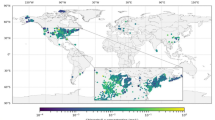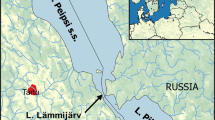Abstract
The relationship between catchment characteristics and lake water chemistry, phytoplankton and periphyton biomass, and phytoplankton and periphyton nutrient limitation was investigated for 30 upland lakes in the U.K. These catchment characteristics included the proportion of different land cover categories in the catchment and some hydrological information. Multiple regression models could predict alkalinity, pH, total dissolved phosphorus, dissolved inorganic nitrogen, dissolved organic nitrogen, dissolved organic carbon and phytoplankton chlorophyll a from the proportional contribution of between two and six land cover categories within the catchment and explain between 42 and 73% of the variance. Phosphorus limitation was positively linked to the proportion of shrub-heath and bracken in the catchment, and negatively linked to the proportion of pasture. Nitrogen limitation was positively linked to the proportion of marsh and rough grass, deciduous and mixed woodland, and negatively linked to the proportion of rough pasture, shrub heath and bare ground in the catchment. Nitrogen limitation decreased and phosphorus limitation increased with catchment slope, although the correlation between land cover classes and slope was not significant. The results suggest that map-based data can be used to predict water chemistry and nutrient limitation in upland lakes.
Similar content being viewed by others
References
Beaulac, M. N. & K. M. Reckhow, 1982. An examination of land use-nutrient export relationships. Wat. Res. Bull. 18: 1013–1024.
Boorman, D. B., J. M. Hollis & A. Lilly, 1995. Hydrology of soil types: a hydrologically-based classification of the soils of the United Kingdom. Report no. 126. Institute of Hydrology, Wallingford: 137 pp.
Dillon, P. J. & L. A. Molot, 1990. The role of ammonium and nitrate retention in the acidification of lakes and forested catchments. Biogeochemistry 11: 23–43.
Elser, J. J., E. R. Marzolf & C. R. Goldman, 1990. Phosphorus and nitrogen limitation of phytoplankton growth in the freshwaters of North America: a review and critique of experimental enrichments. Can. J. Fish. Aquat. Sci. 47: 1468–1477.
ESRI, 1999. ArcView GIS V3.2-User Guide. Environmental Systems Research Institute, Redlands, CA.
Foy, R. H. & A. E. Bailey-Watts, 1998. Observations on the spatial and temporal variation in status of lakes in the British Isles. Soil Use and Management 14: 131–138.
Fuller, R. M., G. B. Groom & A. R. Jones, 1994. The Land Cover Map of Great Britain: an automated classification of Landsat Thematic Mapper data. Photogrammetric Engineering & Remote Sensing 60: 553–562.
Fuller, R. M., G. M. Smith, J. M. Sanderson, R. A. Hill & A. G. Thompson, 2001. Land Cover Map 2000: a parcel-based map from satellite images. Proceedings of the 1st Annual Remote Sensing and Photogrammetry Society Conference, Remote Sensing Society, Nottingham, CDROM.
Gibson, C. E., Y. Wu, S. J. Smith & S. Wolfe-Murphy, 1995. Synoptic limnology of a diverse limnological region: catchment and hydrochemistry. Hydrobiologia 306: 213–227.
Jansson, M., P. Blomqvist, A. Jonsson & A.-K. Bergstrom, 1996. Nutrient limitation of bacterioplankton, autotrophic and mixotrophic phytoplankton, and heterotrophic nanoflagellates in Lake Ortrasket. Limnol. Oceanogr. 41: 1552–1559.
Johnes, P. J., 1996. Evaluation and management of the impact of land use change on the nitrogen and phosphorus load delivered to surface waters: the export coefficient modelling approach. J. Hydrol. 183: 323–349.
Johnes, P. J., B. Moss & G. Phillips, 1996. The determination of total nitrogen and total phosphorus concentrations in freshwaters from land use, stock headage and population data: testing of a model for use in conservation and water quality management. Freshwat. Biol. 36: 451–473.
Johnson, L. B., C. Richards, G. E. Host & J. W. Arthur, 1997. Landscape influences on water chemistry in Midwestern stream ecosystems. Freshwat. Biol. 37: 193–208.
Maberly, S. C., L. King, M. M. Dent, R. I. Jones & C. E. Gibson, 2002. Nutrient limitation of phytoplankton and periphyton growth in upland lakes. Freshwat. Biol. 47: 2136–2152.
Marrs, R. H., J. E. Lowday, L. Jarvis, M. W. Gough & A. P. Rowland, 1992. Control of bracken and the restoration of heathland. IV. Effects of bracken control and heathland restoration treatments on nutrient distribution and soil chemistry. J. Appl. Ecol. 29: 218–225.
McGuckin, S. O., C. Jordan & R. V. Smith, 1999. Deriving phosphorus export coefficients for CORINE land cover types. Wat. Sci. Technol. 39: 47–53.
Miles, J., 1985. The pedogenic effects of different species and vegetation types and the implications of succession. J. Soil Sci. 36: 571–584.
Mitchell, R. J., R. H. Marrs, M. G. Le Duc & M. H. D. Auld, 1997. A study of succession on lowland heaths in Dorset, Southern England: changes in vegetation and soil chemical properties. J. Appl. Ecol. 34: 1426–1444.
Morris, D. G. & R. W. Flavin, 1990. A digital terrain model for hydrology. Proceedings of the 4th International Symposium on Spatial Data Handling. Vol. 1, July 23–27, Zurich: 250–262.
Moss, B., S. Mc Gowan & L. Carvalho, 1994. Determination of phytoplankton crops by top-down and bottom-up mechanisms in a group of English Lakes, the West Midland Meres. Limnol. Oceanogr. 39: 1020–1029.
NERC AA, 1999. Flood Estimation Handbook CD-ROM, Version 1.0. Centre for Ecology and Hydrology, Wallingford.
Nõges, P., T. Nõges, L. Tuvikene, H. Smal, S. Ligeza, R. Kornijóv, W. Peczula, E. Bécases, F. Garcia-Criado, C. Alvarez-Carrera, C. Fernandez-Alaez, C. Ferriol, R. M. Miracle, E. Vicente, E. Van Donk, W. van de Bund, J. P. Jensen, E.M. Gross, L.-A. Hansson, M. Gyllström, E. de Eyto, K. Irvine, D. Stephen, S. Collings & B. Moss, 2003. Factors controlling hydrochemical and trophic state variables in 86 shallow lakes in Europe. Hydrobiologia 506–509: 51–58.
Ormernik, J. M. 1976. The influence of land use on stream nutrient levels. USEPA Ecological Research Series EPA-60013-76-014. US Environmental Protection Agency, Corvallis, OR.
Schindler, D.W., 1977. Evolution of phosphorus limitation in lakes. Science 195: 260–262.
Vollenweider, R. A. & J. Kerekes, 1980. The loading concept as basis for controlling eutrophication philosophy and preliminary results of the OECD programme on Eutrophication. Progr. Wat. Technol. 12: 5–38.
Author information
Authors and Affiliations
Rights and permissions
About this article
Cite this article
Maberly, S.C., King, L., Gibson, C.E. et al. Linking nutrient limitation and water chemistry in upland lakes to catchment characteristics. Hydrobiologia 506, 83–91 (2003). https://doi.org/10.1023/B:HYDR.0000008556.73832.75
Issue Date:
DOI: https://doi.org/10.1023/B:HYDR.0000008556.73832.75




